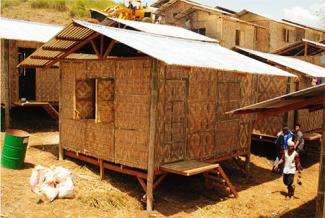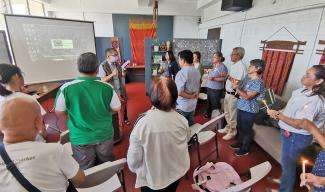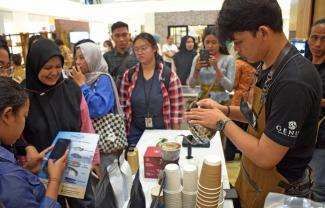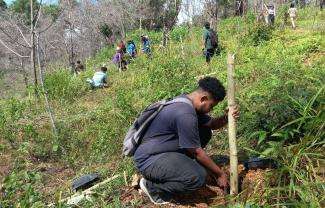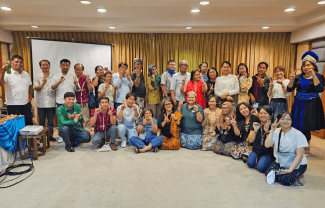Tuburan is one of the barangays in Cagayan de Oro majorly populated by Higaonons or the Indigenous Peoples (IP). Several of its sitios lie along the Iponan River, one of the two major river systems of the city. Many of the residents do artisanal (manual) gold billing and several operate hydraulic or flush mining. Plain land that is suitable to farming of rootcrops, banana and coconuts are also located along the riverbanks. Because of the nature of these livelihood, many families have chosen to reside beside the river. Around 70-80% of the barangay population is IP; many of the families are considered to be below the poverty line with very low income and limited opportunities. The distance from the city center and the inaccessible roads further marginalize the people, as quality basic services do not reach the people, or they do not have easy access to this.
During the TS Sendong, the Iponan River started rising around midnight, but it was only in the early hours of the morning (5-6AM) that the high floodwaters started rampaging through the Iponan River, sweeping away trees, debris, houses, crops and animals. Thankfully in Brgy. Tuburan, there were no casualties. Based on the data-gathering that Samdhana conducted, there were 104 families that were affected by the flood.
In partnership with the International Organization for Migration (IOM), Samdhana helped to facilitate that shelter assistance will be provided to the 75 families whose homes and personal belongings have been washed out. Samdhana's partner in turn is the Barangay Tribal Council headed by Datu Kasaligan Roel Villaverde. We followed IOM's process for the shelter assistance-such as the availability of suitable land for relocation and the validation of beneficiaries. Samdhana helped in bridging the Tribal Council and the IOM staff, as well as in training the community volunteers to conduct the profiling of the targeted beneficiaries. IOM took the lead in doing the courtesy call and coordination with the Barangay LGU, which is also supportive of the project. The IOM provided all building materials and logistics, as well as the human resources, counterparted by labor from the beneficiaries.
The implementation of the shelter assistance in Tuburan happened expeditiously because of the generous donation of Datu Roel for his family-owned and titled land of less than one hectare to be used as the relocation site for the 75 families/ validated beneficiaries. And because the Chairperson of the BLGU posed no objections and supported the initiative, the IOM team was able to quickly move in and start the construction. The design of the house was consulted with Datu Roel and with the Datu's from the neighboring barangays in Tumpagon and Pigsag-an. The house is made of local materials and is a simple one-room design 3.5x4sq.m.
The Barangay Tribal Council of Tuburan has its own system of self-governance for the IPs who still follow their customary way of life. They are part of a federation of 13 barangay tribal councils that are processing their unified Ancestral Domain claim within the boundaries of Cagayan de Oro City. Their aspiration is to be given full recognition of their rights as IPs to their ancestral domain, which means, that they will have access to and be able to benefit from the remaining resources within their traditional territories. One of their concerns is on securing their livelihood, to improve their quality of life and have equal access to opportunities, as well as to be able to live out their customary ways, beliefs and traditions. Brgy. Tuburan is in the middle of the ridge-river-reef continuum of Cagayan de Oro wherein many environmental and social issues—foremost on illegal mining, forest and water protection, dearth of livelihood opportunities, and patronage politics create dynamics that impact negatively on the people, especially on the Indigenous Peoples.
The creation of a new community for the Higaonons in Brgy. Tuburan is an opportunity wherein they can strengthen their tribal governance and where they can put to practice their right to self-determination. Although there are still many needs that have not been addressed as of this time, but the Tribal Council sees that this project has provided them with the chance to create a Higaonon community wherein they practice their batasan (way of life) and where the land and community is treated as a sacred place to build peace and harmony among their tribespeople and with other members of the barangay community.
As of today (Mar.16), IOM is completing the construction of the first 50 houses on the relocation site. There are now plans to provide a water pump and develop the small spring in the area for the people's source of drinking water. Request for assistance in installing electricity and water is already sent to the Barangay LGU. Sanitation and the construction of comfort rooms for each household is still a big concern, and this has also been brought to the attention of the WASH cluster. Many of the family beneficiaries' main concern is still their food security and livelihood, and we hope that with the continuing partnership with the Tribal Council, with the BLGU, and with other local and international concerned agencies, this can be addressed in due time.
The Higaonon families will officially move into their new homes on March 18 and 19, preceded by a community ritual that will give thanks to Magbabaya for the generosity of donors, the commitment and service of their leaders and partners, and to ask for blessings for the new community.
